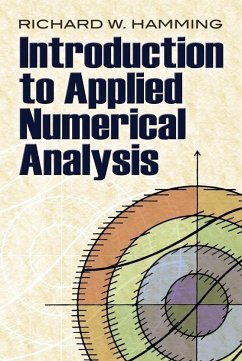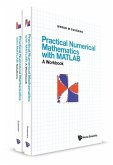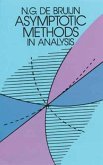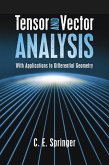R W Hamming
Introduction to Applied Numerical Analysis
R W Hamming
Introduction to Applied Numerical Analysis
- Broschiertes Buch
- Merkliste
- Auf die Merkliste
- Bewerten Bewerten
- Teilen
- Produkt teilen
- Produkterinnerung
- Produkterinnerung
This book covers an extensive range of topics, including round-off and function evaluation, real zeros of a function, integration, ordinary differential equations, optimization, orthogonal functions, Fourier series, and much more. 1989 edition.
Andere Kunden interessierten sich auch für
![Practical Numerical Mathematics with Matlab: A Workbook and Solutions Practical Numerical Mathematics with Matlab: A Workbook and Solutions]() Myron Mike SussmanPractical Numerical Mathematics with Matlab: A Workbook and Solutions89,99 €
Myron Mike SussmanPractical Numerical Mathematics with Matlab: A Workbook and Solutions89,99 €![Introduction to Differential Equations, An: Deterministic Modeling, Methods and Analysis (Volume 1) Introduction to Differential Equations, An: Deterministic Modeling, Methods and Analysis (Volume 1)]() Anilchandra G LaddeIntroduction to Differential Equations, An: Deterministic Modeling, Methods and Analysis (Volume 1)76,99 €
Anilchandra G LaddeIntroduction to Differential Equations, An: Deterministic Modeling, Methods and Analysis (Volume 1)76,99 €![Asymptotic Methods in Analysis Asymptotic Methods in Analysis]() N G de BruijnAsymptotic Methods in Analysis16,99 €
N G de BruijnAsymptotic Methods in Analysis16,99 €![Tensor and Vector Analysis Tensor and Vector Analysis]() C E SpringerTensor and Vector Analysis16,99 €
C E SpringerTensor and Vector Analysis16,99 €![A First Course in Functional Analysis A First Course in Functional Analysis]() Martin DavisA First Course in Functional Analysis10,99 €
Martin DavisA First Course in Functional Analysis10,99 €![Vector and Tensor Analysis Vector and Tensor Analysis]() George E HayVector and Tensor Analysis10,99 €
George E HayVector and Tensor Analysis10,99 €![A History of Vector Analysis A History of Vector Analysis]() Michael J CroweA History of Vector Analysis15,99 €
Michael J CroweA History of Vector Analysis15,99 €-
-
-
This book covers an extensive range of topics, including round-off and function evaluation, real zeros of a function, integration, ordinary differential equations, optimization, orthogonal functions, Fourier series, and much more. 1989 edition.
Produktdetails
- Produktdetails
- Verlag: Dover Publications
- Seitenzahl: 350
- Erscheinungstermin: 15. Februar 2012
- Englisch
- Abmessung: 226mm x 151mm x 25mm
- Gewicht: 478g
- ISBN-13: 9780486485904
- ISBN-10: 0486485900
- Artikelnr.: 33378503
- Herstellerkennzeichnung
- Libri GmbH
- Europaallee 1
- 36244 Bad Hersfeld
- gpsr@libri.de
- Verlag: Dover Publications
- Seitenzahl: 350
- Erscheinungstermin: 15. Februar 2012
- Englisch
- Abmessung: 226mm x 151mm x 25mm
- Gewicht: 478g
- ISBN-13: 9780486485904
- ISBN-10: 0486485900
- Artikelnr.: 33378503
- Herstellerkennzeichnung
- Libri GmbH
- Europaallee 1
- 36244 Bad Hersfeld
- gpsr@libri.de
Richard W. Hamming (1915-98) was an American mathematician whose work had broad implications for computer science and telecommunications. In addition to his work on the Manhattan Project, he taught at New York's City College and the Naval Postgraduate School in Monterey, California. Richard W. Hamming: The Computer Icon Richard W. Hamming (1915-1998) was first a programmer of one of the earliest digital computers while assigned to the Manhattan Project in 1945, then for many years he worked at Bell Labs, and later at the Naval Postgraduate School in Monterey, California. He was a witty and iconoclastic mathematician and computer scientist whose work and influence still reverberates through the areas he was interested in and passionate about. Three of his long-lived books have been reprinted by Dover: Numerical Methods for Scientists and Engineers, 1987; Digital Filters, 1997; and Methods of Mathematics Applied to Calculus, Probability and Statistics, 2004. In the Author's Own Words: "The purpose of computing is insight, not numbers." "There are wavelengths that people cannot see, there are sounds that people cannot hear, and maybe computers have thoughts that people cannot think." "Whereas Newton could say, 'If I have seen a little farther than others, it is because I have stood on the shoulders of giants, I am forced to say, 'Today we stand on each other's feet.' Perhaps the central problem we face in all of computer science is how we are to get to the situation where we build on top of the work of others rather than redoing so much of it in a trivially different way." "If you don't work on important problems, it's not likely that you'll do important work." — Richard W. Hamming
Preface 1. Roundoff and Function Evaluation 2. Real Zeros of a Function 3.
Complex Zeros 4. Zeros of Polynomials 5. Simultaneous Linear Equations and
Matrices 6. Interpolation and Roundoff Estimation 7. Integration 8.
Ordinary Differential Equatioms 9. Optimization 10. Least Squares 11.
Orthogoanal Functions 12. Fourier Series 13. Chebyshev Approximation 14.
Random Processes 15. Design of a Library Index
Complex Zeros 4. Zeros of Polynomials 5. Simultaneous Linear Equations and
Matrices 6. Interpolation and Roundoff Estimation 7. Integration 8.
Ordinary Differential Equatioms 9. Optimization 10. Least Squares 11.
Orthogoanal Functions 12. Fourier Series 13. Chebyshev Approximation 14.
Random Processes 15. Design of a Library Index
Preface 1. Roundoff and Function Evaluation 2. Real Zeros of a Function 3.
Complex Zeros 4. Zeros of Polynomials 5. Simultaneous Linear Equations and
Matrices 6. Interpolation and Roundoff Estimation 7. Integration 8.
Ordinary Differential Equatioms 9. Optimization 10. Least Squares 11.
Orthogoanal Functions 12. Fourier Series 13. Chebyshev Approximation 14.
Random Processes 15. Design of a Library Index
Complex Zeros 4. Zeros of Polynomials 5. Simultaneous Linear Equations and
Matrices 6. Interpolation and Roundoff Estimation 7. Integration 8.
Ordinary Differential Equatioms 9. Optimization 10. Least Squares 11.
Orthogoanal Functions 12. Fourier Series 13. Chebyshev Approximation 14.
Random Processes 15. Design of a Library Index








